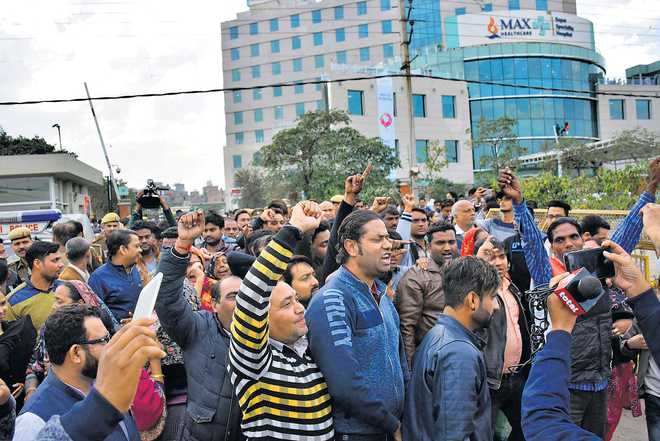
SYSTEMIC FAILURE: People protest outside a Delhi hospital where a newborn baby was declared dead. The tertiary care system in the country is under intense pressure. PTI file
Aditi Tandon in New Delhi
WHEN Infosys co-founder NR Narayana Murthy chose to speak on India’s crumbling health sector at a memorial lecture in Delhi last week, everyone sat up and listened. A sense of curiosity ran through the audience. The answers were clear in Murthy’s conclusion. “Poor public health is the Achilles Heel of Indian economy and a recurring speed breaker in our journey to growth. Public investment in health must increase if demographic dividend is to be reaped,” he said, citing disconcerting statistics on India’s poor life expectancy, high child and maternal mortality, low nutrition and rising non-communicable disease burden.
On all major health outcomes, India fares poorly among 11 WHO South East Asia Region nations - Maldives, Sri Lanka, Thailand, Bangladesh, DPR Korea, Bhutan, Nepal, Indonesia, Timor-Leste, India and Myanmar. India with 68.3 years life expectancy is better than only Bhutan at 66.6 years. We have the fifth highest On infant deaths, India, with 44 deaths per 1,000 live births, ranks third from the bottom above Myanmar and Timor-Leste.
‘Political priority’
World Health Organization’s India representative Henk Bekedam says the country needs to make health a political priority and raise budget for it. Citing huge out-of-pocket expenditure (OOP) on health — 64.2% — of all health expenditure in India, Bekedam says China reduced OOP on health from 60% in 2005 to 35% now. “Before the outbreak of Severe Acute Respiratory Syndrome, China was spending one per cent of its GDP on health. Now it spends 3 pc,” Bekedam says.
In India the public spending on health is still 1 per cent of the GDP. With current government spending in the sector either low or stagnant, an unregulated private sector continues to flourish and caters to 80% of India’s health needs.
Max and Fortis examples show how private sector is booming with impunity. The Centre’s hands are tied. It had in 2010 passed The Clinical Establishment Regulation Act mandating private healthcare facilities in an attempt to rationalize prices of services and procedures. But less than seven states have implemented the law. “Health is a state subject. The Act has faced opposition from the Indian Medical Association from day one,” says a health ministry official.
Former Health Secretary Sujatha Rao has accused private sector lobbies for stalling health reforms and breeding corruption.
Rao said scrapping of National Eligibility-cum-Entrance Test (NEET) in 2013 happened under pressure from private hospitals and politicians. NEET was finally implemented following the Apex Court orders last year. Tamil Nadu is still contesting it.
The vast gap
Out of 479 medical colleges, 227 are government-run, the rest are private. Out of 67,218 MBBS seats, 31,278 are in government medical colleges and 36,040 are in private ones.
“India has one doctor for 1,630 patients whereas WHO recommends one for every 1,000,” records the draft National Medical Commission Bill which seeks to replace the Medical Council of India as the regulator of medical sector and education in a bid to root out private corruption. The Bill awaits Cabinet’s clearance amid severe political pressures.
Dr VK Paul of NITI Ayog and HoD, Pediatrics, AIIMS, says the need of the hour is investment in primary healthcare at village level where accessible services can be made available to local people. “Eighty per cent budgets of sensible nations go to primary healthcare. WHO has also said that primary healthcare is the key to universal health coverage,” he says.
Ambitious plans
The government is working on a plan to set up 1,50,000 sub-centres across villages each catering to 5000 people. After every six sub centres, there will be a primary health centre; after four PHCs, there will be a community centre which will offer the patient the first contact with tertiary care.
Evidence shows nations with strong primary health access have high life expectancy like the UK (81 years); Sweden (82 years) and Brazil (74 years).
“If you miss a high blood pressure patient, he/she is likely to get a heart attack at 47 years. If you track the patient down, you delay heart attack possibility until 58 years. Early screening is the bedrock of universal health coverage,” says Dr Paul.
The National Health Policy talks of strengthening primary health sector with two third of the budget meant for this area. Today only about 15 pc of the health budget goes for primary care.
Plans are also afoot to create a cadre of mid-level health providers such as paramedics, to be stationed at sub-centres and PHCs where MBBS doctors are unwilling to go.
This cadre will be above ANMs and below doctors and will address basic health needs of people besides referring them to secondary or tertiary hospital care if necessary. A three-year course is being drafted to create this specialized community health worker cadre to serve as mid level providers for improved access.



























